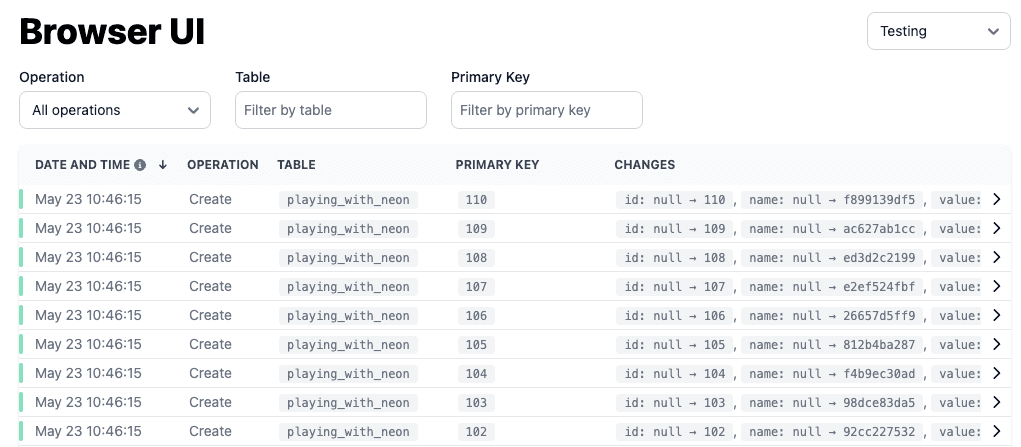Create an automatic audit trail with Bemi
Learn how to create an automatic audit trail for your Postgres database with Bemi
Bemi is an open-source solution that plugs into Postgres and ORMs such as Prisma, TypeORM, SQLAlchemy, and Ruby on Rails to track database changes automatically. It unlocks robust context-aware audit trails and time travel querying inside your application.
Designed with simplicity and non-invasiveness in mind, Bemi doesn't require alterations to your existing database structure. It operates in the background, empowering you with data change tracking features.
In this guide, we'll show you how to connect your Neon database to Bemi to create an automatic audit trail.
Prerequisites
- A Bemi account
- A Neon account
- Read the important notices about logical replication in Neon before you begin
Enable logical replication in Neon
Bemi tracks changes made in a Postgres database through Change Data Capture (CDC), which is a process of identifying and capturing changes made to your database tables in real-time. In Postgres, CDC is supported by the Postgres logical replication feature. In this step, we'll enable logical replication for your Neon Postgres project.
important
Enabling logical replication modifies the Postgres wal_level configuration parameter, changing it from replica to logical for all databases in your Neon project. Once the wal_level setting is changed to logical, it cannot be reverted. Enabling logical replication also restarts all computes in your Neon project, meaning active connections will be dropped and have to reconnect.
To enable logical replication in Neon:
- Select your project in the Neon Console.
- On the Neon Dashboard, select Settings.
- Select Logical Replication.
- Click Enable to enable logical replication.
You can verify that logical replication is enabled by running the following query from the Neon SQL Editor:
SHOW wal_level;
wal_level
-----------
logicalConnect your Neon database to Bemi
The following instructions assume you are connecting with a Postgres role created via the Neon Console, API, or CLI. These roles are automatically granted membership in a neon_superuser group, which has the Postgres REPLICATION privilege. The role you use to connect to Bemi requires this privilege. If you prefer to create a dedicated read-only role for use with Bemi, see Use a read-only Postgres role for Bemi.
To connect your database to Bemi:
-
In Neon, retrieve your database connection string from the Connection Details widget on the Project Dashboard, which will look similar to this:
postgresql://neondb_owner:AbC123dEf@ep-cool-darkness-123456.us-east-2.aws.neon.tech/neondb?sslmode=require -
In Bemi, select Databases > Add Database to open the Connect PostgreSQL Database dialog.
-
Enter the Neon database connection details from your connection string. For example, given the connection string shown above, enter the details in the Connect PostgreSQL Database dialog as shown below. Your values will differ except for the port number. Neon uses the default Postgres port,
5432.- Host: ep-cool-darkness-123456.us-east-2.aws.neon.tech
- Port: 5432
- Database Name: neondb
- Username: neondb_owner
- Password: AbC123dEf
You can also use the Environment field to specify whether the configuration is for a Production, Staging, or Test environment.

-
After entering your connection details, click Add Database.
-
Configure the tables you want to track changes for and choose whether to track new tables automatically. You can change this selection later, if necessary.

Click Save to continue.
-
Wait a few minutes while Bemi provisions the infrastructure. When this operation completes, you’ve successfully configured a Bemi Postgres source for your Neon database. You'll be able to track data changes through the Bemi Browser UI page, where you can filter by Operation (
Create,Update,Delete), Table, or Primary Key. You can also view data changes by environment if you have configured more than one.
Use a read-only Postgres role for Bemi
If preferred, you can create a dedicated read-only Postgres role for connecting your Neon database to Bemi. To do so, run the commands below. The commands assume your database resides in the public schema in Postgres. If your database resides in a different schema, adjust the commands as necessary to specify the correct schema name.
CREATE ROLE: Creates a new read-only user for Bemi to read database changes.CREATE PUBLICATION: creates a "channel" that we'll subscribe to and track changes in real-time.REPLICA IDENTITY FULL: enhances records stored in WAL to record the previous state (“before”) in addition to the tracked by default new state (“after”).
-- Create read-only user with REPLICATION permission
CREATE ROLE [username] WITH LOGIN NOSUPERUSER NOCREATEDB NOCREATEROLE REPLICATION PASSWORD '[password]';
-- Grant SELECT access to tables for selective tracking
GRANT SELECT ON ALL TABLES IN SCHEMA public TO [username];
-- Grant SELECT access to new tables created in the future for selective tracking
ALTER DEFAULT PRIVILEGES IN SCHEMA public GRANT SELECT ON TABLES TO [username];
-- Create "bemi" PUBLICATION to enable logical replication
CREATE PUBLICATION bemi FOR ALL TABLES;
-- Create a procedure to set REPLICA IDENTITY FULL for tables to track the "before" state on DB row changes
CREATE OR REPLACE PROCEDURE _bemi_set_replica_identity() AS $$ DECLARE current_tablename TEXT;
BEGIN
FOR current_tablename IN SELECT tablename FROM pg_tables LEFT JOIN pg_class ON relname = tablename WHERE schemaname = 'public' AND relreplident != 'f' LOOP
EXECUTE format('ALTER TABLE %I REPLICA IDENTITY FULL', current_tablename);
END LOOP;
END $$ LANGUAGE plpgsql;
-- Call the created procedure
CALL _bemi_set_replica_identity();note
After creating a read-only role, you can find the connection details for this role in the Connection Details widget in the Neon console. Use this role when connecting your Neon database to Bemi, as described above.
Allow inbound traffic
If you're using Neon's IP Allow feature, available with the Neon Business plan, to limit IP addresses that can connect to Neon, you will need to allow inbound traffic from Bemi. Contact Bemi to get the static IPs that need to be allowlisted. For information about configuring allowed IPs in Neon, see Configure IP Allow.